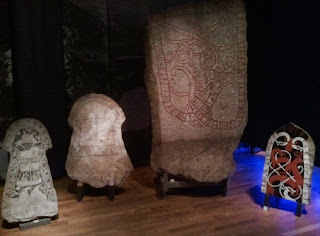This time TAG in Bournemouth brought about something I did not believe was to happen ever. I was in the winning Antiquity Quiz team; still those eight words make me smile Mona-Lisa-smile. Since those two team members who actually knew most of the answers did have their Antiquity subscriptions, I was the most vocal member of the team lacking it and thus landed myself a free Antiquity subscription for a year. We had not even considered the possibility of winning, so we had to go through the negotiations about the destiny of the free subscription AFTER our win. The subscription came on top of the Antiquity mug and the photo that the editorial secretary took (see below - you can find it in their Twitter feed).
Those who are regular visitors in the Theoretical Archaeology Group conferences know that the quiz is perennially won by the team in which Colin Renfrew is a member. I can remember only one time when another team managed to bag the win. That time the winners had Andrew Fleming and Chris Scarre in their winning tean. The former was in our team this year as well, so we had some hope, but did not really count our blessings. I had mentioned in the pub where a group of us – most of us from the CAA-UK scene – were having our hamburgers that I am pants in the quiz and just does not know the random Neolithic monuments across the counties that crop up in the questions. I reckon we could not have done it alone without our senior members. I did know exclusively the answer to two of the questions, but that would have not got us very far...
On a more serious note, our session went fine, even if Phil had to do the school run duty and the session chairing was my responsibility. The discussions on the taskscapes were vibrant – although I was the only speaker who did not get any questions. Either I was so clear or unclear in my comparison of taskscape and ceramiscene. Tim Ingold himself was telling us how he imagined the concept of taskscpae and how he has occasionally checked what people have been doing with it. To his slight dismay we archaeologists are discussing maps with it, but that seems to be what archaeologists do. Tim was also pointing out to the future and suggesting that a mesh may be a good analogue for the way people go about long lines in the landscape.
The session stayed very discursive until the end. The numbers of listeners dropped dramatically after the lunch break, but only the anthropology session seemed to have decent numbers. At the beginning both Colin Renfrew and Julian Thomas were sitting in the session, not to mention a wide audience of other known academic figures, regular TAG visitors, students and foreign visitors. The numbers did drop after the morning coffee, but we still got the Antiquity editor in exchange of those who had headed to the other sessions.
The overarching theme of the 20 years of taskscape session was the interaction of past and modern archaeological taskscapes. The research process was considered a modern taskscape that revealed information on past temporalities and activities. Chronologically the papers ranged from the Stone Age [lithics] by Astrid Nylund to the 1950s [nuclear observation points] by Bob Clarke. The pottery papers were in the afternoon, but considering the questions the systematic XRF study of pottery and clay sources in Tavoliere by Keri Brown reached a knowledged audience and I and Phil can appreciate the ceramiscene interpretation of historic pottery kiln by Matt Edgeworth exceeding the boundaries of the kiln itself. The latter again juxtaposed the excavation by the now extinct BUFAU unit with the activities related to the kiln site. Now we can only hope that the Nordic TAG session will be a similar success and we will end up with a good publication (or two).
Otherwise the running themes of TAG included some good archaeo-astronomy and some very imaginative fictional archaeo-astronomical interpretations and different takes on anthropology and material culture. The catchphrases of the days were the assemblage, meshwork and networking. These concepts will undoubtedly live until the next TAG and beyond.












